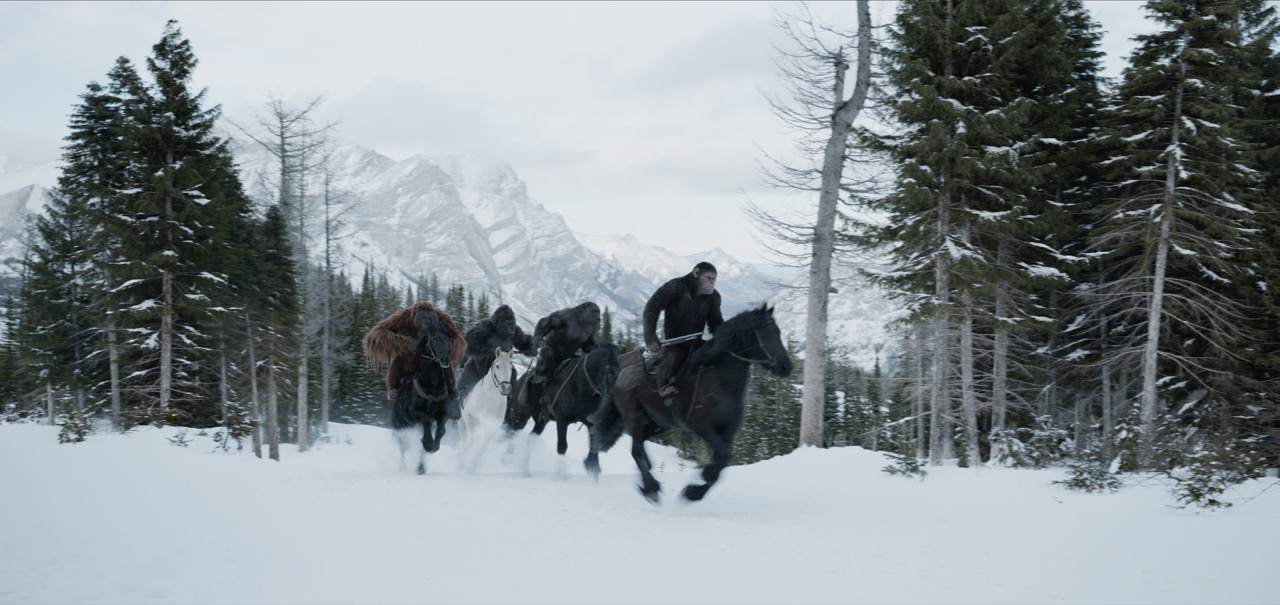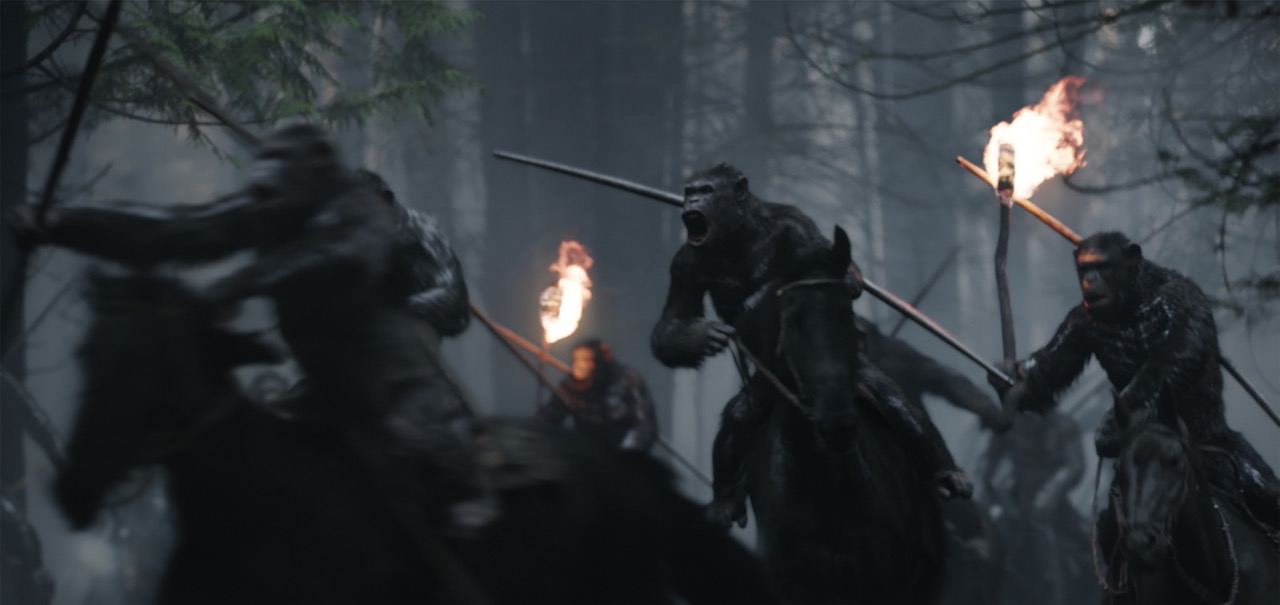 Ed Halter
Ed Halter
In director Matt Reeves’s trilogy-ender, a final showdown in the Northern California woods.

Still from War for the Planet of the Apes. Image courtesy Twentieth Century Fox-TM. © 2017 Twentieth Century Fox Film Corporation.
War for the Planet of the Apes, directed by Matt Reeves
• • •
One of the teaser trailers for director Matt Reeves’s War for the Planet of the Apes begins with a sequence that echoes the beachside finale of Planet of the Apes, the 1968 film from which the longstanding cinematic franchise has evolved. In the clip, the grimly determined alpha chimpanzee Caesar, his orangutan confidant Maurice, and a blond human child journey on horseback across an otherwise empty shore, where wet sands glisten against dawn light. The immediately arresting image of apes riding horses has been a visual staple of Planet of the Apes throughout its various permutations. In the 1968 version, crash-landed astronauts initially encounter intelligent apes in the startling form of equestrian gorillas hunting humans; mounted apes appear prominently in the opening credits of the 1974 Planet of the Apes television series, as well as on the poster for Tim Burton’s 2001 remake; and simian cavalry play a decisive role in the cross-species battle on the Golden Gate Bridge that serves as the climax of the 2011 reboot, Rise of the Planet of the Apes.
This enduring story element is a purely cinematic invention—in Pierre Boulle’s 1963 science-fiction novel La Planète des Singes, the basis for the first film, the apes drive automobiles. In his 1947 essay “The Horse: Totem-Symbol of American Films,” the great critic Parker Tyler argues that the image of rider and horse, so iconic to the western, contains the entire underlying myth of the genre—the triumph of man over beast, and thus civilization over nature—since this image, Tyler writes, so succinctly “provides an emblem, as well as a drama, of mastery.” Replacing humans and putting another animal in the saddle invokes an entire alternate history that could have made it so, a cosmic reversal of fortune begging for explanation.

Still from War for the Planet of the Apes. Image courtesy Twentieth Century Fox-TM. © 2017 Twentieth Century Fox Film Corporation.
War culminates a trilogy that began with Rise and continued with 2014’s Dawn of the Planet of the Apes; the three movies detail how the apes achieve consciousness, then finally supplant humans after protracted struggle. The social allegories famously central to the original series of films, wherein a hierarchy of primate species stands in for the all-too-human history of racial domination, were largely discarded for Rise and Dawn; those films chose instead to evoke biological terrors and environmental disaster. The apes’ intelligence emerges as a byproduct of a new Alzheimer’s cure for which they were test subjects; Homo sapiens is first decimated by a deadly “simian flu” pandemic, then doomed by the global chaos that ensues. In War, Caesar’s burgeoning ape colony in the woods of Northern California is threatened by a straggly band of soldiers, led by the maniacal Colonel (Woody Harrelson), who attempt a final stand for humanity’s future. One of the more unnerving aspects of the film is how it sets us up to root for the defeat of our own species. With shades of ethnic cleansing, this conflict brings back some of the political valences of the earlier series: a particularly sharp twist is the kapo-style apes who collaborate with humans against their own kind.
The mechanics of communication played a prominent role in the last two films. Rise focuses on Caesar’s acquisition of language; Dawn shows how those skills spread through a growing simian community, who employ an ape-inflected form of ASL to converse among themselves, augmented by snatches of rudimentary verbalizing whose syntax likely owes more to the Tarzan movies than any proper linguistics. Since War is largely told from the perspective of the apes, with Harrelson’s Colonel as the only significant and persistent human role, large stretches of the film depict complex flutterings of ape hands in untranslated conversation, punctuated by facial expressions and the occasional hoot.

Still from War for the Planet of the Apes. Image courtesy Twentieth Century Fox-TM. © 2017 Twentieth Century Fox Film Corporation.
This elaborate, largely silent language is one of the more fascinating aspects of the film, simultaneously invoking both empathy and alienation. Another variation on this theme is articulated through the numerous dramatic close-ups of simian visages, upon which the tiniest facial inflections are transmitted from the production’s human actors to the splendidly textured digital characters via advanced motion-capture systems. While the ingenious combination of mime, puppetry, and computer animation required for such a feat is indeed impressive, remember that the foam-and-latex masks of the original films were just as effective as expressive tools, even if they didn’t provide the same level of illusory realism. Moreover, consider the ironies of a cautionary tale about humanity’s self-destruction from scientific overreach that serves as an awe-struck celebration of advanced image-generating technologies.
Understandably numb from the barrage of half-baked superhero films, critics have been quick to praise War as one of the most intelligent and innovative blockbusters in recent memory. In comparison to its summertime competition, this is undoubtedly true; but for all its spectacular digital wizardry, War is nevertheless inferior to both Rise and Dawn. While the latter two movies drew upon the disaster-film genre for their narrative power, efficiently imagining the horrifying outcomes of a bizarre apocalyptic crisis, the latest installment draws much too liberally from canonical war films like Apocalypse Now, Full Metal Jacket, The Great Escape, and Gladiator, larding its narrative with wink-wink references that only a first-year film student would love. As it shifts away from human characters and becomes more fully embedded in a world of simian simulation, so too does War become a game of genre in-jokes and unproductive world-building. It tries to hold a mirror up to humanity, but merely provides a romp through a forest of empty signifiers.
Ed Halter is a founder and director of Light Industry, a venue for film and electronic art in Brooklyn, New York, and Critic in Residence at Bard College in Annandale-on-Hudson, New York. His writing has appeared in Artforum, The Believer, frieze, Mousse, The Village Voice, and elsewhere. He is the recipient of the Thoma Foundation 2017 Arts Writing Award in Digital Art for an emerging arts writer, awarded by the Carl & Marilynn Thoma Art Foundation.